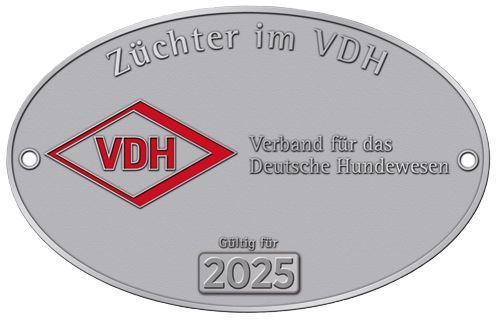On the health of the Nihon Ken
In general, all Nihon Ken are still very healthy, or as the layman might put it: not overbred. However, some diseases are becoming increasingly common. We would like to briefly introduce and explain these here. We will then briefly list them under the respective breed.
Genetics - Breeding selection
A good breeder examines his dogs for (hereditary) diseases that can occur in the breed. The gene pools are sometimes very small and narrow, which may promote these diseases.
Many clubs have separate and different regulations for breeding. Each breeder must use the flexibility they provide on their own responsibility.
For the good of the breed - breeding means improving (health) and maintaining (standard). We are not God and should experiment, because you never know what the consequences will be!
Eye diseases
PRA - progressive retinal atrophy
PRA is a genetic disease. It encompasses a variety of retinal degenerations in dogs that lead to congenital blindness. Courses and variations include early or late onset, autosomal recessive, dominant, or X-linked.
PRA-PRCD
PRCD stands for progressive rod-cone degeneration. It is an autosomal, late-onset, and recessive inherited eye disease. It initially leads only to night blindness and loss of peripheral vision. Eventually, it leads to loss of daytime vision and, typically, complete blindness.
This disease is evident to a veterinarian at approximately 1.5 years of age. Painless symptoms become apparent to the owner between 3 and 5 years of age. Increased reflectivity (visual appearance) and gradually constricting pupils in the light can be observed.
PRA-CRD4/ CORD-1
Cone-rod dystrophy 4, also a recessive eye disease, is similar to PRA-PRCD. Only in this case, the dog first loses its daytime vision, then its night vision, leading to complete blindness. The average age of onset is 5 years, but varies greatly.
PPM - Persistent Pupillary Membrane
During embryonic development, the pupil as such is not yet present. It is filled with vascular tissue. This tissue regresses completely at birth or shortly thereafter. If this regression does not occur completely, the remaining remnants are referred to as PPM, which can impair vision.
CEA - Collie Eyes
CEA, or Collie Eye Anomaly, is a congenital developmental disorder. Visual impairment is rare. If accompanied by retinal detachment and/or intraocular hemorrhage (which can also occur later), it can lead to blindness.
The disease is hereditary, but does not occur in connection with specific characteristics (coat color, merle gene, coat type).
A diagnosis is only possible before the child reaches the age of 8 weeks. Gene carriers can be identified through blood analysis.
Joints and bones
Knee - PL - Patella Luxation
The knees and joints can move in and out during movement. Like other joint diseases, PL is not only hereditary but also influenced by many environmental factors, such as incorrect movement. Signs include limping and lameness, which may require surgery.
The PL is classified according to numbers after testing the "movability" of the kneecaps in certain positions. These numbers are written L/R.
Grade 0 - The patella cannot be completely pushed out of the trochlear groove in any position.
Grade 1 - The patella may be completely dislocated; spontaneous reduction occurs when pressure is adjusted.
Grade 2 - The patella may be completely dislocated. Movement of the hindlimb or manual pressure may result
for repositioning.
Grade 3 - The patella is found to be dislocated. Reduction is possible. Adjusting the pressure will cause
luxate.
Grade 4 - The patella is permanently dislocated. Repositioning is not possible.
HD - hip dysplasia
A disease that occurs in many breeds. For diagnosis, the dog requires an x-ray, under sedation. HD is not purely genetic in nature. Unfortunately, there is currently no cure. It can be compared to osteoarthritis in humans. It progresses continuously and is often age-related.
Obvious signs may include: limited/restricted movement, unsteady gait, pain, inability to stand up, or even collapse.
The hip joints are not positioned correctly in the sockets and show signs of degenerative disease. The angles are measured, usually using the Norberg method. These then indicate the degree of hip deformity, taking other factors into account.
Classification is primarily based on letters, but numbers can also be found, as with ED. A combined evaluation can also be done using a letter and a 1 or 2.
HD A - clear
HD B - transitional form
HD C - mild HD
HD D - medium HD
HD E - severe HD
ED - Elbow Dysplasia
The counterpart to HD, in which the front legs are affected, ED is not as acute as HD. For diagnosis, the dog is also x-rayed under sedation.
The evaluation is similar to HD.
ED 0 - free
ED 1 - Transitional form
ED 2 - mild ED
ED 3 - medium ED
ED 4 - severe ED
Panosteitis
Panosteitis is an inflammation of the bone tissue. The cause is unknown. Male dogs are more commonly affected than female dogs, as well as medium and large breeds. First of all, this disease also heals spontaneously! Usually within a few weeks, rarely several months.
Commonly seen between 5 and 18 months of age, but also as early as 2 months or as late as 5 years. A painful disease with possible accompanying lameness. The forelimbs are often affected first. The disease can spread to other limbs. Panosteitis can occur with generalized symptoms such as fever, lethargy, etc.
polyarthritis
A joint inflammation similar to human rheumatism (rheumatoid arthritis). It is an inflammatory autoimmune disease. There are also infectious and non-infectious forms of arthritis.
Not to be confused with its similar and often closely related partner, osteoarthritis.
Hypodontia
= the absence of one or more teeth. A hereditary predisposition. The opposite is hyperdontia (excess number), which should not be confused.
Other dental defects/problems include jaw crowding, overbite and underbite
Internal organs
Heart
Mainly, heart murmurs, valvular septal defects, and pulmonary artery stenosis can occur. In young puppies, they can be an indication of congenital heart disease, a defect the puppy was born with. It may be a harmless murmur that should disappear by 4 months of age at the latest, but otherwise requires further diagnosis.
Cryptorchidism
This is a "very harmless condition." It occurs when one or both testicles fail to descend properly into the scrotum. The testicles develop near the kidneys in the abdomen and usually descend into the scrotum by 2 months of age. It can also occur later, but not/less frequently after 6 months.
Cryptochidism occurs when the testicles cannot be felt in the scrotum after two to four months. Dogs with this condition should be excluded from breeding, as it is hereditary. The internal testicle must be surgically removed, as it usually degenerates.
Allergies - Intolerances
A problem that's becoming increasingly common, just like in humans. Symptoms include itchy skin combined with scratching or biting, hair loss, changes in skin color and texture, and hot spots.
To diagnose an allergy, you either have to test the food, up to 5 months before the "toxins" have left the dog's body, or have a blood test (not necessarily in the case of food intolerances) done by a veterinarian.
congenital sebaceous adenitis
It is a rare, idiopathic, immune-mediated disease characterized by a selective inflammatory reaction followed by destruction of the sebaceous glands. It usually occurs in middle age. It usually begins on the head, ears, and tail, later affecting the back. Adherent silvery scales form, and hair breakage occurs.
Seborrheic dermatitis is incurable. However, relief can be achieved with sprays and shampoos or cyclosporine (capsules). Combined use is even better, and the intervals or dosage can be reduced later.
Vestibular syndrome
It is a sudden disorder of the vestibular system. The vestibular system consists of a part in the inner ear and a part in the brain. Its primary function is to maintain body balance and coordinate head and eye movements.
Symptoms include head tilt, rapid eye movements, unsteady gait, walking in circles, and, in severe cases, falling to the side. Accompanying symptoms include nausea and refusal to eat.
Treatment and prognosis depend on the underlying cause (ear or brain). In the idiopathic form (unknown cause/no pathomechanism -> symptom = disease), supportive medications for circulatory and blood flow are sufficient. Further support is provided by treating the accompanying symptoms, rest, and vitamin supplements. The symptoms disappear, and a normal life is possible. In rare cases, a slight tilt of the head remains, but this does not impair quality of life.
Epilepsy - Seizures
A serious neurological condition. The dog drools, stiffens, and collapses. It is a sudden, unpredictable event of varying duration and triggering stimuli. Treatment is limited, but sometimes unsuccessful.
GM gangliosidosis
It is a lipid storage disease and is classified into types 1, 2, or 3. It results in non-degradable deposits due to an enzyme deficiency in the nerve cells. This leads to neurological deficits that manifest early (a few weeks) and later (<1 year) lead to death, or euthanasia prevents unnecessary suffering. Currently, there is no cure. This hereditary disease can only be prevented through selective breeding and testing.
Cancer
Cancer is already familiar to many people through human medicine. No one is safe from it. Not even our furry friends. Unfortunately, it's impossible to say when, how, or even if cancer will occur. Only that there are many forms that we can live with, or simply let go of...
Cystinuria
There are three different types, and this hereditary metabolic disorder occurs in several animal species, including humans. It is heterogeneous (phenotypically and genetically).
Cystinuria is a metabolic disorder of amino acid transport (cystine - problematic; lysine, ornithine and aeginine - unproblematic) in the kidneys.
In dogs, cystine, which is insoluble in urine, accumulates. Crystals and stones form, leading to irritation of the urinary tract. This results in difficult and painful urination, susceptibility to urinary tract infection, and, in the worst case, blockage. Male dogs are most commonly affected due to their different anatomy (longer urinary tract).
A cure/relief is usually only possible through surgery (in cases of blockage to prevent kidney failure or bladder rupture). Medication can also be used to make the urine alkaline, thus stimulating the solubility of cystine and preventing it. An adjusted diet can also help prevent this.






